Lobelia cardinalis, or the ‘cardinal flowers’ plant as it is commonly known, is a flowering perennial within the Campanulaceae family, commonly known as the ‘bellflower’ family.
This plant may be of particular interest to the American gardener as it is native to the Americas, both North and South, and grows specifically in wet or swampy areas common in the South Of the United States and also across Central and South America.
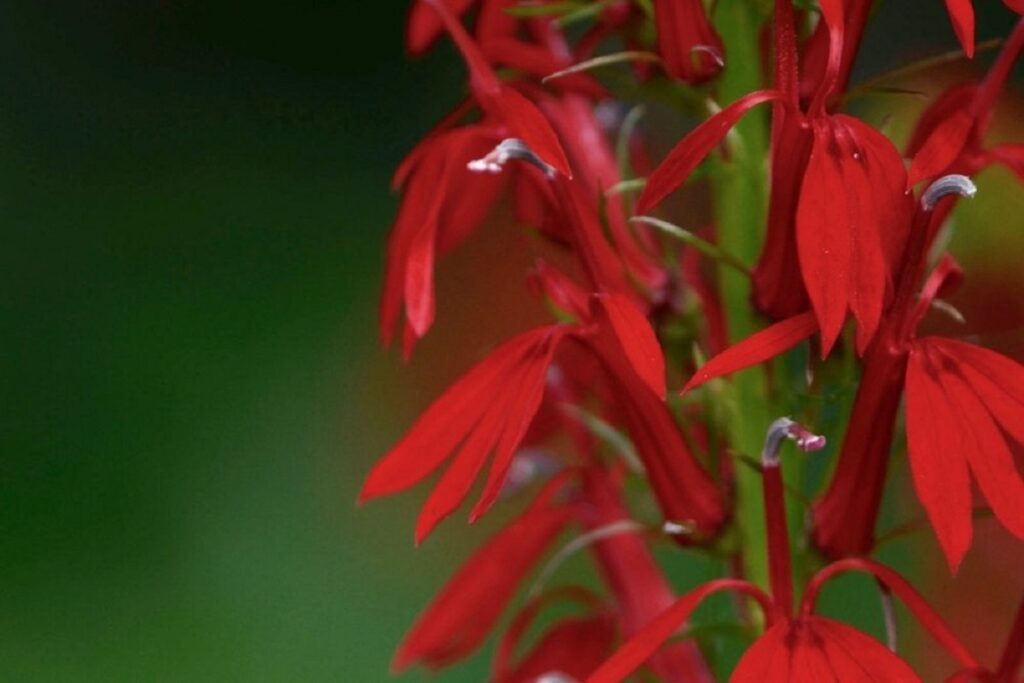
Worth noting is the poisonous nature of the plant that is common for the Lobelia genus, don’t go eating this one.
The cardinal flower is a herbaceous plant that has some bright green foliage and can grow to around four feet tall.
The plant is commonly seen in the wild on the banks of rivers and in the swampy areas of the south of the US and thus requires some rich and well watered soil.
Multiple flower heads form out of the raceme inflorescence and the petals are often delicate and elegant. Tall and erect stamens burst from the plant and are often the same color as the flower head itself
While the word ‘cardinal’ has little to do with horticulture, the name likely comes from the similarity of the flower’s color to the robes and garments of the cardinal within the Roman Catholic church.
This seems true if you consider the plant was introduced into Europe during the early 16th century when Roman Catholicism was rife in Europe.
However, in this guide we are going to show you many cultivars of the Lobelia cardinalis that aren’t necessarily the cardinal red that has come to be associated with this flower.
There are actually many cultivars out there that display more colors than simply red, and could suit your garden better. Read on to learn more about the cardinal red Lobelia cardinalis, as well as the other color options out there.
1. Lobelia Cardinalis ‘Queen Victoria’
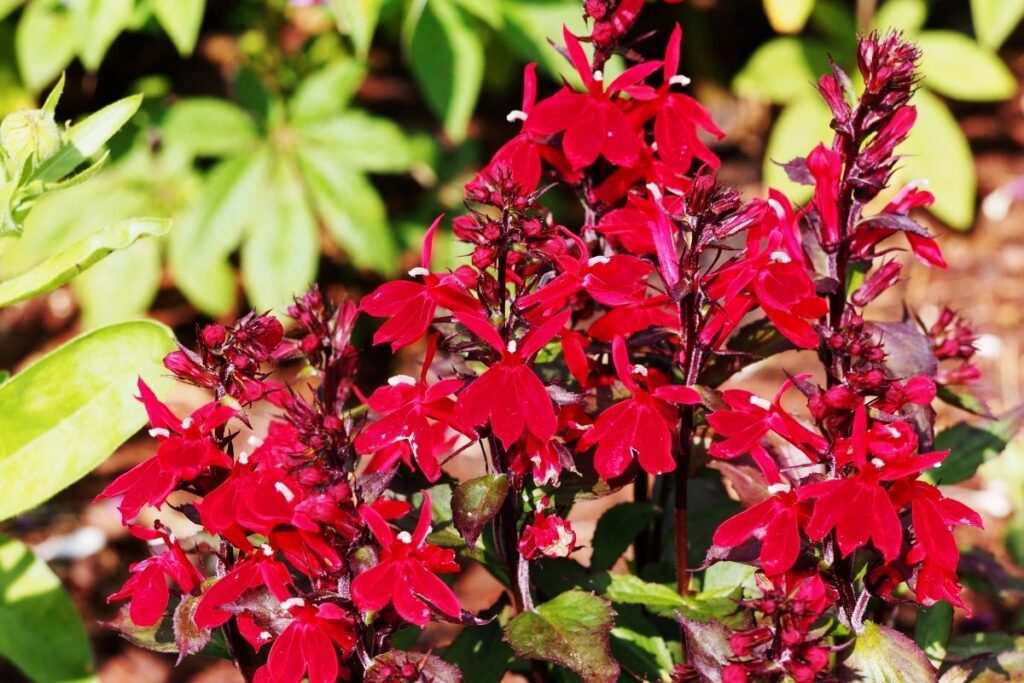
This particular cultivar is perhaps the most well known among all the cardinal flower cultivars, and has won a Award of Garden Merit from the prestigious Royal Horticultural Society for this reason.
The plant is cultivated greatly as it epitomises what the cardinal flower is known for. Not only is the flower a perfect shade of cardinal red, but the foliage itself is a dark and brooding maroon that really makes the red flower pop and makes the whole plant very dramatic.
The tall foliage is as spiky as Old Vic herself, but the flowers are particularly bright and bring great color to a damp area of your garden.
The plant is particularly well utilised next to a pond or perhaps a stream in a stately home. The plant will remain hardy while flowering but is relatively short lived.
The general flowering period of the general species is around August to October, meaning that you can get some great flashes of red to end your gardening season on a high.
2. Lobelia Cardinalis ‘Black Truffle’
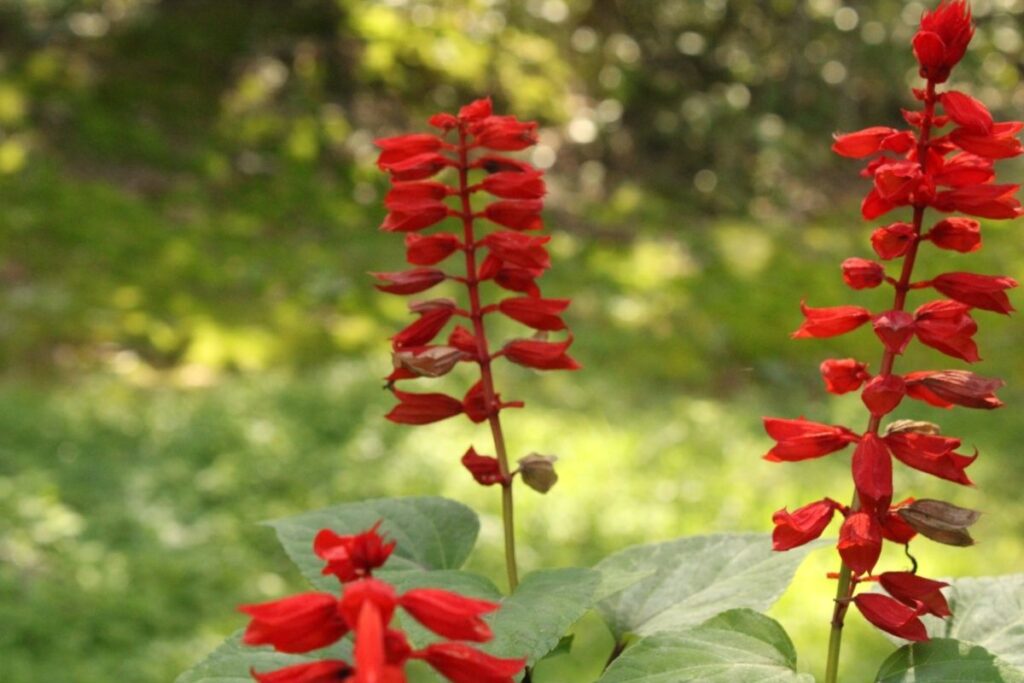
This cultivar is fairly similar to the previous with slight color and height differences that could suit your garden and usage better. ‘Queen Victoria’ will generally produce more flower heads than ‘Black Truffle’ on the racemes.
The foliage of ‘Black Truffle’ is generally a lot more brown and green than the red and purple foliage of ‘Queen Victoria’.
This generally means that foliage is a lot darker and little less bright than the previous cultivar. This cultivar is a pretty hardy one and was discovered in West Virginia so when grown around this region it should survive the winter cold pretty well.
This ‘Black Truffle’ cultivar, sometimes called ‘Chocolate Truffle’ by certain nurseries, also blooms late into the summer and is a great plant to consider when landscaping an aquatic or damp area.
The dark foliage is particularly dramatic and elegant next to the shimmering water. If you can’t find ‘Queen Victoria’ at your local nursery, this is a very comparable cultivar.
3. Lobelia Siphilitica ‘Alba’
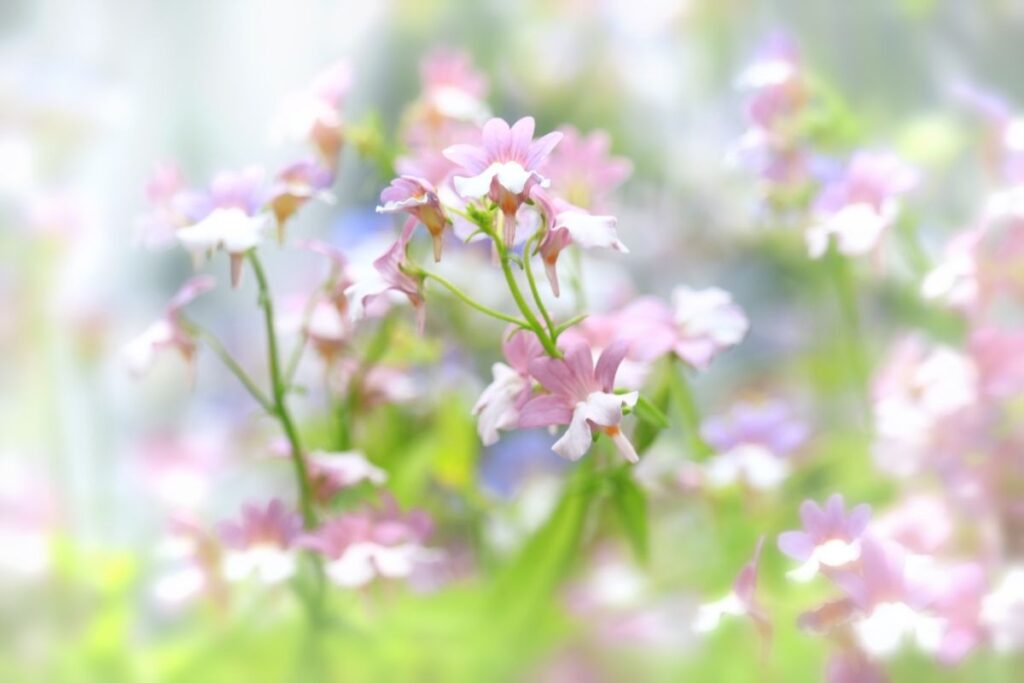
This Lobelia cultivar, commonly called the ‘white cardinal flower’ has a similar inflorescence to its red friends, but the colors are slightly different.
The tubular formation of petals that erect the tall stamen are perfectly white in color. Of even greater contrast to the previous cultivars, this ‘Alba’ cultivar has bright green foliage and stems that provides a much cleaner and bright feeling than the brooding and dramatic ‘Queen Victoria’.
Again, this is particularly suited to aquatic or marshy areas, but the colors bring some really quieting and elegant feelings to your pond or stream that is very calming and peaceful.
The green foliage will look great and really pop against the dark mulch of the marshy banks. It has a similar flowering period and height to the cardinalis subspecies.
For the wildlife watchers among us, it’s worth noting that the plant is of particular attraction to the hummingbird. So if you want to observe the humble hummingbird with some beautiful flowers and shimmering aquatic features, consider the cardinal flower as your bargaining chip with this animal.
4. Lobelia Siphilitica ‘Great Blue’
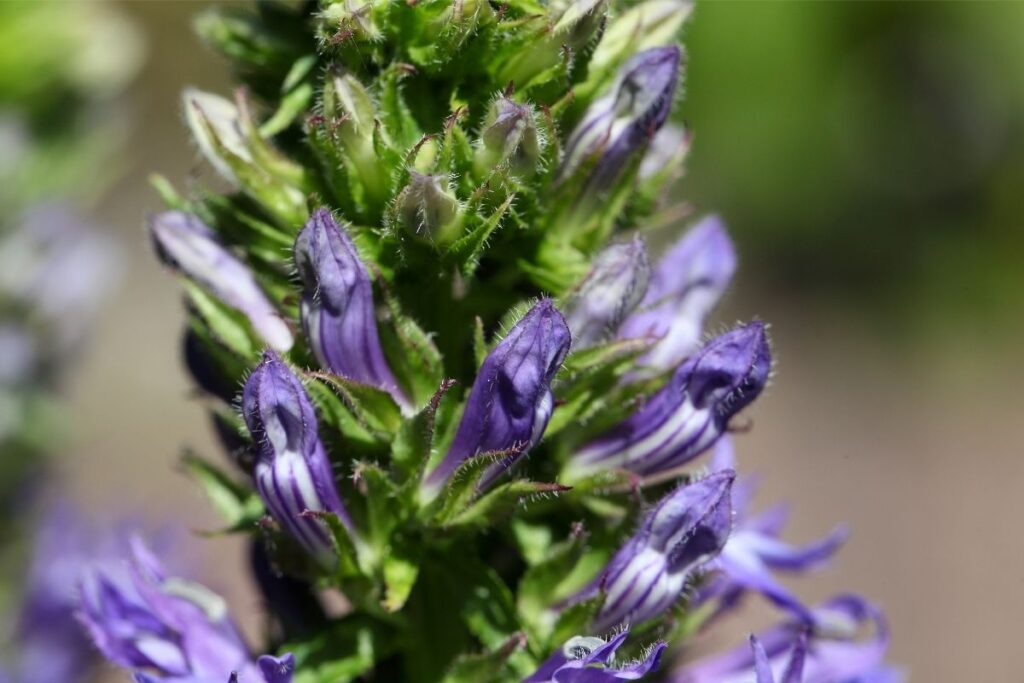
Many plant nerds, even horticulturists, may be surprised to learn of the blue cardinal flower. While not necessarily a rare plant by any means, it simply is overlooked by its showy cousin teh cardinalis for its red flower. However, worth noting is this elegant and dreamy blue flowering Lobelia.
Like the ‘Alba’ variety, this cultivar retains the very bright and lively green foliage that is a clean and natural way to cut through the mulch of the damp area that the Lobelia enjoys.
The blue flowers are particularly dreamy and have the ability to make your aquatic area enchanting like a fairy tale. Just think of the painting ‘Ophelia’ by John Everett Millais.
Worth noting is the rather funny etymology of ‘siphilicata’ which, as you can perhaps guess, is indeed related to the disease ‘syphilis’, rife in the 1600s, which this species of Lobelia was thought to cure.
They were quite far off with this, though, but don’t think of eating this species as it is as toxic as any other Lobelia is – we can still enjoy its beauty with our eyes, though.
RELATED: 18 Beautiful True Blue Flowers (Including Pictures)
5. Lobelia Erinus ‘Crystal Palace’
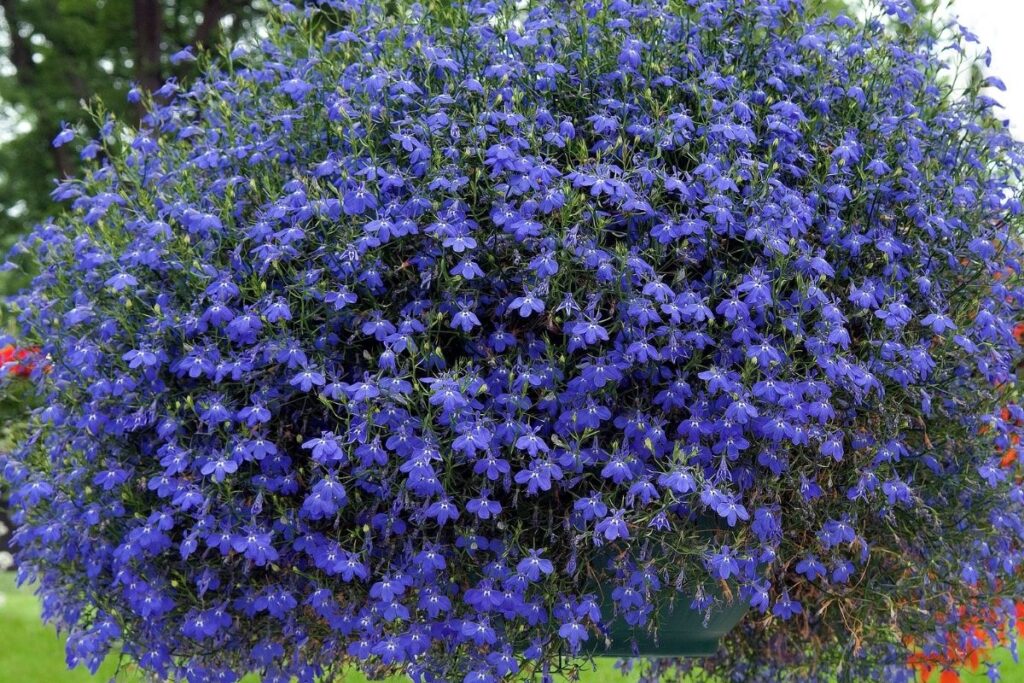
Moving away from the cardinalis, the erinus ‘Crystal Palace’ cultivar is worth mentioning for its deserved popularity thanks to its longer flowering period than the cardinalis – expect the flowering period to be around June to September.
Still pretty hardy, this plant can spread up to 5 inches and is a semi shrub. This, when planted in the aquatic area it enjoys, can really hug your pond or create a nice bed by a stream.
The inflorescent morphology is still very similar to the cardinal flower but the color of each flower head is a deep and dreamy sapphire color that is really enchanting. When flowering the bushes form clouds of ethereal purple flowers that can really add that fairytale feel to your aquatic garden.
Many chose to grow these in planters and can even look great in a metropolitan area, as long as they are well watered, to create some lovely clouds of color during the summer months and into September.
The dark green foliage and stems provides the perfect backdrop for these purple flowers to really sing and only adds to the fairytale feelings its compact flowers will conjure up. This is a really easy way to add color to your aquatic garden all the way through summer.
The Final Word
There you have it, the cardinal flower. While the cardinal flower can refer specifically to the Lobelia cardinalis, it definitely isn’t the only one worth looking into.
There are many types of Lobelia that have very similar flowers, some really epitomise the emotions we relate to the cardinal red color, while others help us enjoy the Lobelia and its subspecies through an appreciation of other colors.
The Lobelia, and particularly the cardinal flower, is a great and fairly easy way to get your aquatic areas to pop. Aquatic gardens are always a pesky area to get looking good, but when you achieve the look you want it can really be an enchanting and peaceful area of your garden.
Moreover, the Lobelia is pretty versatile and you can even grow them in pots and planters, as a result they are pretty popular within metropolitan gardens and on people’s balconies as they do bring a lasting pop of color that is desirable in any situation.
We hope this article has shown the variety of colors and species of the Lobelia that go beyond the simple and well known cardinal red color.
If you haven’t even heard of this plant before, we hope this guide could encourage you to really get the most out of your aquatic areas and turn what may just be a watering hole into a beautiful and enchanting garden that anyone can enjoy.
Aquatic gardens are certainly a project worth panning out, but knowing about the humble Lobelia, often overlooked for its potential poisonous quality, will give you some ideas and a place to get started.







